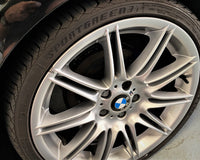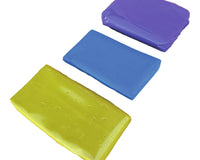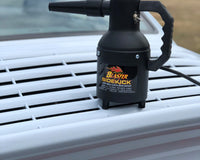There's something deeply satisfying about a car that looks freshly detailed, its paintwork gleaming under the sunlight. But maintaining that showroom finish between proper washes can feel like an impossible challenge. This is where the often-overlooked practice of quick detailing becomes your secret weapon – a professional technique that keeps your vehicle looking its best with minimal time and effort.
Understanding the Quick Detailing Process
Quick detailing is essentially a maintenance cleaning method designed to refresh your car's appearance without the full commitment of a traditional wash. It's particularly valuable for those times when your vehicle has accumulated light dust or fingerprints, but doesn't require a complete cleaning session. The beauty of this approach lies in its simplicity and efficiency, allowing you to preserve that just-detailed look with relatively little effort.
The process typically involves using specially formulated sprays that gently lift surface contaminants while adding a protective layer to enhance shine. Unlike traditional washing that can take considerable time and resources, a proper quick detailing session can be completed in about fifteen to twenty minutes when done correctly. This makes it ideal for busy individuals who still want to maintain their vehicle's appearance.
Why This Maintenance Method Matters
Regular quick detailing offers several significant benefits that go beyond mere aesthetics. First and foremost, it serves as a protective measure for your paintwork. By removing fresh contaminants before they have a chance to bond to the surface, you're preventing potential damage that could lead to more serious issues down the road. This proactive approach is far more effective than dealing with problems after they've become established.
Another advantage is the preservation of existing protective coatings. Whether your car has a traditional wax or a more advanced ceramic coating, quick detailing helps maintain these protective layers by removing contaminants that could degrade them over time. The result is longer-lasting protection and better performance from whatever products you've applied to your vehicle's surfaces.
Perhaps most appealing is the time-saving aspect. In our busy lives, finding hours for proper car care can be challenging. Quick detailing provides a practical solution that fits into tight schedules while still delivering noticeable results. It's the perfect compromise between doing nothing and committing to a full wash when time is limited.
Essential Equipment for Effective Quick Detailing
To achieve professional-quality results, you'll need to assemble some basic tools. The foundation of any quick detailing setup begins with high-quality cleaning cloths. These should be exceptionally soft and plush to ensure they glide over surfaces without causing micro-scratches. Having several on hand allows you to use fresh ones as needed during the process.
The cleaning solution itself is another critical component. Look for formulations designed specifically for quick detailing purposes, as these contain the right balance of cleaning agents and lubricants to safely remove surface contaminants. Avoid generic cleaners that might be too harsh or leave residues behind.
For more thorough cleaning of intricate areas, soft-bristled brushes prove invaluable. These help reach into grilles, around badges, and other tight spots where dust tends to accumulate. Similarly, having dedicated tools for wheels ensures you're not transferring brake dust and road grime to your paintwork.
The Professional Step-by-Step Approach
Proper technique is what separates effective quick detailing from simply wiping down your car. Begin by selecting an appropriate location – ideally in shade and away from direct sunlight. This prevents products from drying too quickly and causing streaks.
Start at the highest points of the vehicle and work your way downward. This top-to-bottom approach ensures any dislodged dirt falls onto areas you haven't cleaned yet rather than contaminating freshly detailed surfaces. Apply your chosen cleaning product to the surface rather than directly onto your cloth for more even distribution.
Use gentle, straight-line motions when wiping to minimize the chance of creating swirl marks. Frequently flip your cloth to expose clean surfaces, and never use the same side that's touched dirt to wipe clean areas. Pay special attention to horizontal surfaces like the hood and roof, which tend to accumulate the most contaminants.
For wheels and lower body panels that typically collect more road grime, use separate cloths to prevent cross-contamination. Finish with glass surfaces using an appropriate cleaner to ensure streak-free visibility.

Common Mistakes and How to Avoid Them
Even with the best intentions, it's easy to make errors that compromise your results. One frequent mistake is using dirty or inappropriate cloths. Always start with freshly cleaned materials designed for automotive surfaces. Regular household towels often contain fibers that are too coarse and can scratch delicate clear coats.
Another pitfall is working in direct sunlight or high temperatures. This causes products to dry almost immediately, leaving behind residues and streaks. If you must work in warm conditions, work in smaller sections and mist surfaces lightly to extend working time.
Over-applying products is another common issue. More isn't necessarily better – using excessive amounts can lead to buildup that actually attracts more dust. Follow product instructions carefully and use just enough to achieve the desired effect.
Perhaps the most significant mistake is attempting to quick detail a car that's actually too dirty for the process. If you can feel significant grit when running your hand over the paint, or see visible dirt accumulation, it's time for a proper wash instead. Quick detailing works best on light surface dust and fingerprints, not heavy soiling.
When to Opt for Traditional Washing Instead
Understanding the limitations of quick detailing is just as important as mastering the technique itself. There are certain situations where this maintenance method simply isn't appropriate and could potentially cause more harm than good.
Vehicles with heavy dirt accumulation, especially from muddy or salty roads, require traditional washing. The same applies if you notice any gritty texture when running your hand over the paint. These conditions demand more thorough cleaning that only proper washing can provide.
Similarly, if your car has tree sap, bird droppings, or other stubborn contaminants, spot cleaning these areas before quick detailing is essential. These substances can etch into paint if not removed properly and given special attention.
Incorporating Interior Maintenance
A complete quick detailing session shouldn't neglect the interior. While not as intensive as a full interior detail, taking a few minutes to address cabin surfaces maintains that fresh feeling throughout your vehicle.
Start by removing any loose debris and trash. Use a soft brush to gently dust vents, instrument clusters, and other delicate areas. Wipe down hard surfaces with appropriate cleaners, being careful around electronic components. A quick vacuum of high-traffic areas like floor mats and seats keeps the interior looking tidy between deeper cleans.
Developing a Sustainable Routine
The true power of quick detailing emerges when it becomes part of a regular maintenance routine. Establishing a consistent schedule based on your driving patterns and environment ensures your car always looks its best.
For daily drivers exposed to urban environments, weekly quick detailing sessions might be appropriate. Vehicles that see less use or are garage-kept may only need bi-weekly attention. Pay attention to seasonal changes too – spring pollen or winter road salt may necessitate more frequent sessions during certain times of year.
The Long-Term Benefits
While the immediate results of quick detailing are visibly apparent, the long-term advantages are even more compelling. Regular maintenance helps preserve your vehicle's paint integrity, preventing the accumulation of damage that requires costly correction later.
This proactive approach also extends the life of any protective coatings you've applied, whether it's traditional wax or more advanced solutions. By keeping these layers free of contaminants, they can perform as intended for longer periods.
Perhaps most importantly, maintaining your car's appearance through regular quick detailing preserves its value. A well-kept vehicle not only looks better but also commands higher resale prices when the time comes to upgrade.
Conclusion
Mastering the art of quick detailing transforms car maintenance from a chore into a satisfying ritual. This professional technique bridges the gap between full washes, keeping your vehicle looking immaculate with minimal time investment. By understanding the proper methods, tools, and frequency, you can maintain that showroom-fresh appearance day after day.
Remember that quick detailing complements rather than replaces traditional washing. Used as part of a comprehensive care routine, it becomes an invaluable tool for preserving your car's beauty and value. With practice, these quick sessions will become second nature, ensuring your vehicle always makes the right impression wherever you go.
The road to automotive perfection begins with small, consistent steps. Start incorporating these quick detailing techniques into your routine today, and enjoy the satisfaction of driving a car that always looks its absolute best.




